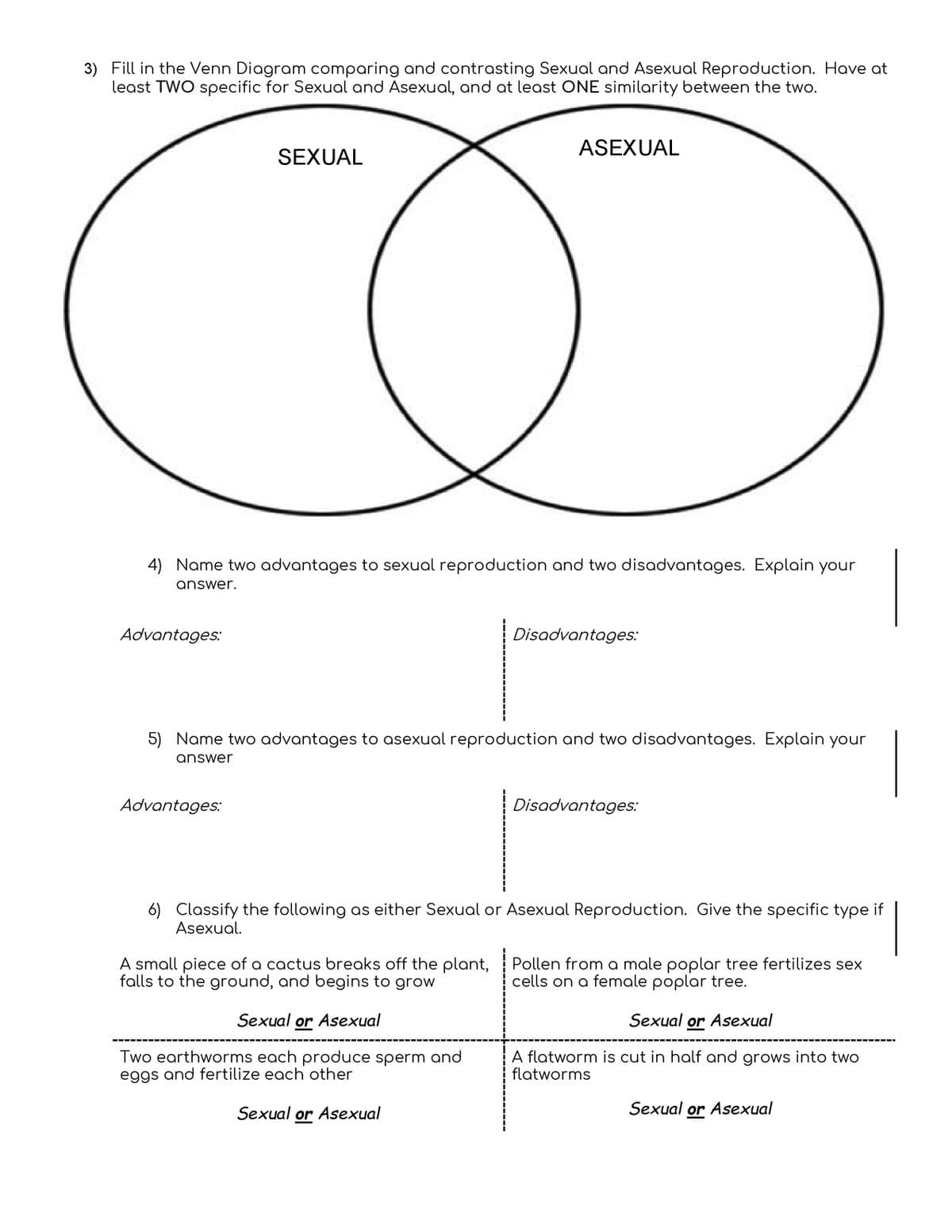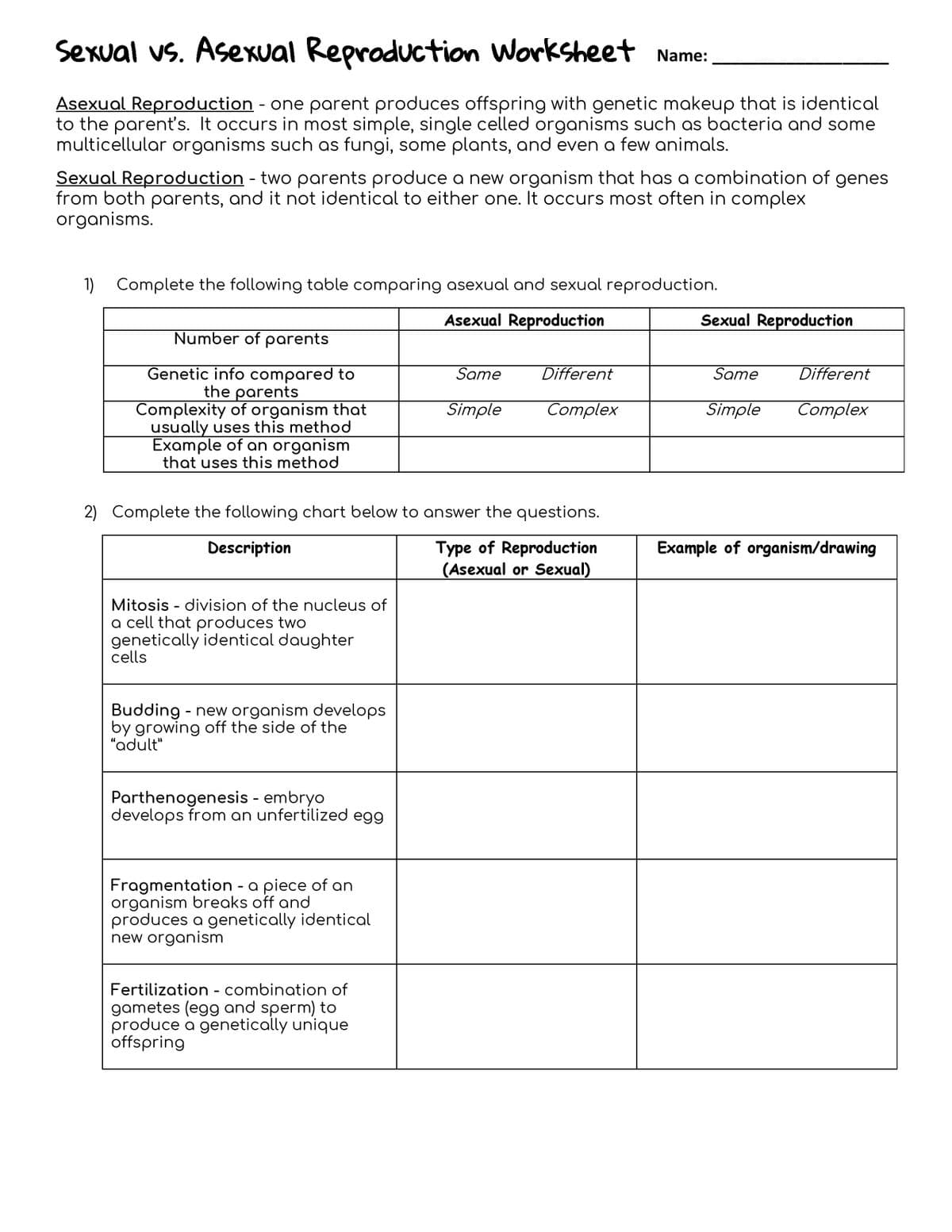3) Fill in the Venn Diagram comparing and contrasting Sexual and Asexual Reproduction. Have at least TWO specific for Sexual and Asexual, and at least ONE similarity between the two. ASEXUAL SEXUAL 4) Name two advantages to sexual reproduction and two disadvantages. Explain your answer. Advantages: Disadvantages: 5) Name two advantages to asexual reproduction and two disadvantages. Explain your answer Advantages: Disadvantages: 6) Classify the following as either Sexual or Asexual Reproduction. Give the specific type if Asexual. A small piece of a cactus breaks off the plant, falls to the ground, and begins to grow Pollen from a male poplar tree fertilizes sex cells on a female poplar tree. Sexual or Asexual Sexual or Asexual Two earthworms each produce sperm and eggs and fertilize each other A flatworm is cut in half and grows into two flatworms Sexual or Asexual Sexual or Asexual Sexual vs. Asexual Reproduction Worksheet Name: Asexual Reproduction - one parent produces offspring with genetic makeup that is identical to the parent's. It occurs in most simple, single celled organisms such as bacteria and some multicellular organisms such as fungi, some plants, and even a few animals. Sexual Reproduction - two parents produce a new organism that has a combination of genes from both parents, and it not identical to either one. It occurs most often in complex organisms. 1) Complete the following table comparing asexual and sexual reproduction. Asexual Reproduction Sexual Reproduction Number of parents Genetic info compared to the parents Complexity of organism that usually uses this method Example of an organism that uses this method Same Different Same Different Simple Complex Simple Complex 2) Complete the following chart below to answer the questions. Type of Reproduction (Asexual or Sexual) Description Example of organism/drawing Mitosis - division of the nucleus of a cell that produces two genetically identical daughter cells Budding - new organism develops by growing off the side of the "adult" Parthenogenesis - embryo develops from an unfertilized egg Fragmentation - a piece of an organism breaks off and produces a genetically identical new organism Fertilization - combination of gametes (egg and sperm) to produce a genetically unique offspring
3) Fill in the Venn Diagram comparing and contrasting Sexual and Asexual Reproduction. Have at least TWO specific for Sexual and Asexual, and at least ONE similarity between the two. ASEXUAL SEXUAL 4) Name two advantages to sexual reproduction and two disadvantages. Explain your answer. Advantages: Disadvantages: 5) Name two advantages to asexual reproduction and two disadvantages. Explain your answer Advantages: Disadvantages: 6) Classify the following as either Sexual or Asexual Reproduction. Give the specific type if Asexual. A small piece of a cactus breaks off the plant, falls to the ground, and begins to grow Pollen from a male poplar tree fertilizes sex cells on a female poplar tree. Sexual or Asexual Sexual or Asexual Two earthworms each produce sperm and eggs and fertilize each other A flatworm is cut in half and grows into two flatworms Sexual or Asexual Sexual or Asexual Sexual vs. Asexual Reproduction Worksheet Name: Asexual Reproduction - one parent produces offspring with genetic makeup that is identical to the parent's. It occurs in most simple, single celled organisms such as bacteria and some multicellular organisms such as fungi, some plants, and even a few animals. Sexual Reproduction - two parents produce a new organism that has a combination of genes from both parents, and it not identical to either one. It occurs most often in complex organisms. 1) Complete the following table comparing asexual and sexual reproduction. Asexual Reproduction Sexual Reproduction Number of parents Genetic info compared to the parents Complexity of organism that usually uses this method Example of an organism that uses this method Same Different Same Different Simple Complex Simple Complex 2) Complete the following chart below to answer the questions. Type of Reproduction (Asexual or Sexual) Description Example of organism/drawing Mitosis - division of the nucleus of a cell that produces two genetically identical daughter cells Budding - new organism develops by growing off the side of the "adult" Parthenogenesis - embryo develops from an unfertilized egg Fragmentation - a piece of an organism breaks off and produces a genetically identical new organism Fertilization - combination of gametes (egg and sperm) to produce a genetically unique offspring
Human Biology (MindTap Course List)
11th Edition
ISBN:9781305112100
Author:Cecie Starr, Beverly McMillan
Publisher:Cecie Starr, Beverly McMillan
Chapter17: Development And Aging
Section: Chapter Questions
Problem 4CT: The complications of ectopic pregnancy (Section 17.2) are life-threatening for the mother, and in...
Related questions
Question
Fill in the blanks and elaborate each answers.

Transcribed Image Text:3) Fill in the Venn Diagram comparing and contrasting Sexual and Asexual Reproduction. Have at
least TWO specific for Sexual and Asexual, and at least ONE similarity between the two.
ASEXUAL
SEXUAL
4) Name two advantages to sexual reproduction and two disadvantages. Explain your
answer.
Advantages:
Disadvantages:
5) Name two advantages to asexual reproduction and two disadvantages. Explain your
answer
Advantages:
Disadvantages:
6) Classify the following as either Sexual or Asexual Reproduction. Give the specific type if
Asexual.
A small piece of a cactus breaks off the plant,
falls to the ground, and begins to grow
Pollen from a male poplar tree fertilizes sex
cells on a female poplar tree.
Sexual or Asexual
Sexual or Asexual
Two earthworms each produce sperm and
eggs and fertilize each other
A flatworm is cut in half and grows into two
flatworms
Sexual or Asexual
Sexual or Asexual

Transcribed Image Text:Sexual vs. Asexual Reproduction Worksheet Name:
Asexual Reproduction - one parent produces offspring with genetic makeup that is identical
to the parent's. It occurs in most simple, single celled organisms such as bacteria and some
multicellular organisms such as fungi, some plants, and even a few animals.
Sexual Reproduction - two parents produce a new organism that has a combination of genes
from both parents, and it not identical to either one. It occurs most often in complex
organisms.
1) Complete the following table comparing asexual and sexual reproduction.
Asexual Reproduction
Sexual Reproduction
Number of parents
Genetic info compared to
the parents
Complexity of organism that
usually uses this method
Example of an organism
that uses this method
Same
Different
Same
Different
Simple
Complex
Simple
Complex
2) Complete the following chart below to answer the questions.
Type of Reproduction
(Asexual or Sexual)
Description
Example of organism/drawing
Mitosis - division of the nucleus of
a cell that produces two
genetically identical daughter
cells
Budding - new organism develops
by growing off the side of the
"adult"
Parthenogenesis - embryo
develops from an unfertilized egg
Fragmentation - a piece of an
organism breaks off and
produces a genetically identical
new organism
Fertilization - combination of
gametes (egg and sperm) to
produce a genetically unique
offspring
Expert Solution
Step 1
Living organisms, which include humans, animals, plants, algae, fungi and other microorganisms reproduce as a law of nature, a means of ensuring the survival of the species and in the context of evolution. There are two major classifications of reproduction: sexual and asexual reproduction.
Please find below Venn diagram form the comparison and contrast between sexual and asexual mode of reproduction :
Trending now
This is a popular solution!
Step by step
Solved in 2 steps with 1 images

Knowledge Booster
Learn more about
Need a deep-dive on the concept behind this application? Look no further. Learn more about this topic, biology and related others by exploring similar questions and additional content below.Recommended textbooks for you

Human Biology (MindTap Course List)
Biology
ISBN:
9781305112100
Author:
Cecie Starr, Beverly McMillan
Publisher:
Cengage Learning

Human Biology (MindTap Course List)
Biology
ISBN:
9781305112100
Author:
Cecie Starr, Beverly McMillan
Publisher:
Cengage Learning